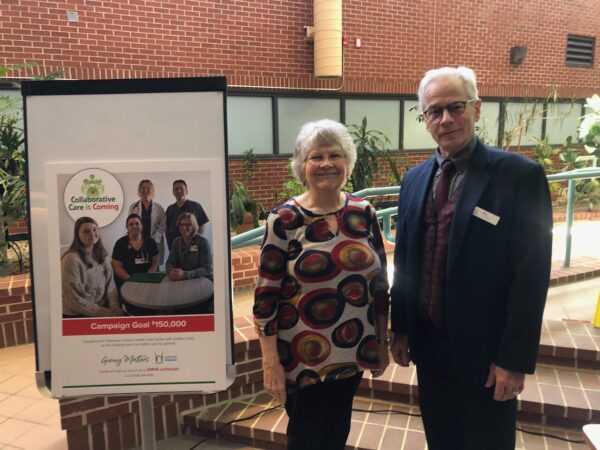
Three provincial groups are calling for reform of the province’s ambulance services, and what they say is an increasing reliance on volunteer fire departments to fill in the gaps in rural ambulance services.
“There is a gap in what should with the coverage should be,” says Roger Pitre, first vice president of the New Brunswick Association of Fire Chiefs and fire chief in Rogersville. “We’re being asked to fill that gap.”
The association of fire chiefs is joining the Union of Municipalities of New Brunswick (UMNB) and the Paramedic Association of New Brunswick in a joint call to address what they call “long-standing structural issues” with the system before the province renews its contract for the delivery of ambulance service with Medavie Health Services in 2027.
Pitre says there’s design flaws with the current dynamic dispatch system that result in ambulances being moved out of rural communities whenever urban ambulances are tied up with calls or offload delays at hospitals. That increases rural response times, and creates a need for rural fire departments to be called in.
In 2020, then auditor general Kim Adair-MacPherson reported that the way Ambulance NB’s performance is measured actually hides problems in rural areas, and “puts rural and remote communities at a disadvantage.”
Ambulance NB has targets of 8 minutes and 22 minutes to respond to calls in urban and rural areas, respectively. And there’s incentives built into their contract that give financial bonuses if they meet those targets 90% of the time. But the results are averaged across rural and urban communities, which means the service is incentivized to focus on urban response times, where the number of calls are higher, to keep their average above 90%. When the auditor general’s office crunched the numbers on a community-by-community basis in 2020, they found 19 out of 67 communities fell below the 90% target, and all those were located outside of New Brunswick’s cities.
Concerns about ‘subsidization’
UMNB president and mayor of Grand Bay Westfield Brittany Merrifield says municipalities, through their fire departments, have been subsidizing services that Ambulance NB is under contract to deliver. Merrifield says UMNB doens’t have a figure on how much medical calls are costing local fire departments, but says that since 2010, about 157,000 calls for assistance have gone to fire departments across the province.
“We’re concerned about the cost of subsidization,” says Merrifield, but also “the impact on our firefighters” and “the safety of our residents,” when it comes to longer waits for ambulances.
There are some local fire departments that have made the decision to take on more medical calls. Fire departments in Dorchester, Memramcook, and 10 other communities in the province have invested in training and equipment to support the ability to attend calls as medical first responders. But this is not something all rural fire departments have the capacity to take on, says Pitre.
“If their municipalities are on board to give them that mandate and to support their resource needs,” says Pitre, “that’s completely in order.” But, he says, there are many departments across the province without training and equipment who “get called anyhow because of the gap in a timely ambulance service.”
Chris Hood says that even in the case of fire departments that willingly took on medical first responder duties, the volume of calls has been increasing. The Executive Director at the Paramedic Association of New Brunswick says, “it’s increasing year over year, and the system just cannot continue to sustain itself.”
Hood points to the latest numbers from Port Elgin, which showed that in April 2024, 16.7% of calls met the 22-minute target. The month before, in March 2024, Ambulance NB hit it highest performance target in Port Elgin for the year, at 82.7%. In Sackville, Ambulance NB met the 22-minute response target from 67.1% to 83.3% of the time.
‘System is broken’
Hood says its not a case of whether trained medical first responders in local fire services are up to the task, but about whether they should be left to pick up the slack for Medavie Health Services, which in 2023 received $287 million from the province to run Ambulance NB and Extra Mural health.
“We can’t continue to burden the system of the fire service to overcome the shortcomings of what is very much a highly paid, very expensive paramedic system,” says Hood.
“The system, as it stands today, is broken,” says Hood, adding that he doesn’t necessarily blame Medavie or Ambulance NB.
Their “hands are somewhat tied because they’re in a contractual relationship,” says Hood. “What we’re saying is we’ve got two years before a new contract needs to get signed with this company, or whoever. Now is the time to start planning for what a new system will look like and how we can do it better.”
“It’s time to start with a community needs assessment,” says Hood. “We have contractual performance indicators that probably aren’t reflective of what is reasonable. So we’re saying we need to look and build the foundation of the system appropriately.”
Hood says the three groups have a meeting scheduled with the Minister of Health John Dornan in the coming weeks to discuss their call for changes.
“We really want to be consulted as municipalities more frequently on the effectiveness of ambulance services,” says Merrifield, “particularly in more rural areas.”
“We want to be involved in that process,” says Merrifield, “so that these experiences that we’re talking about here are incorporated into that future contract.”



















